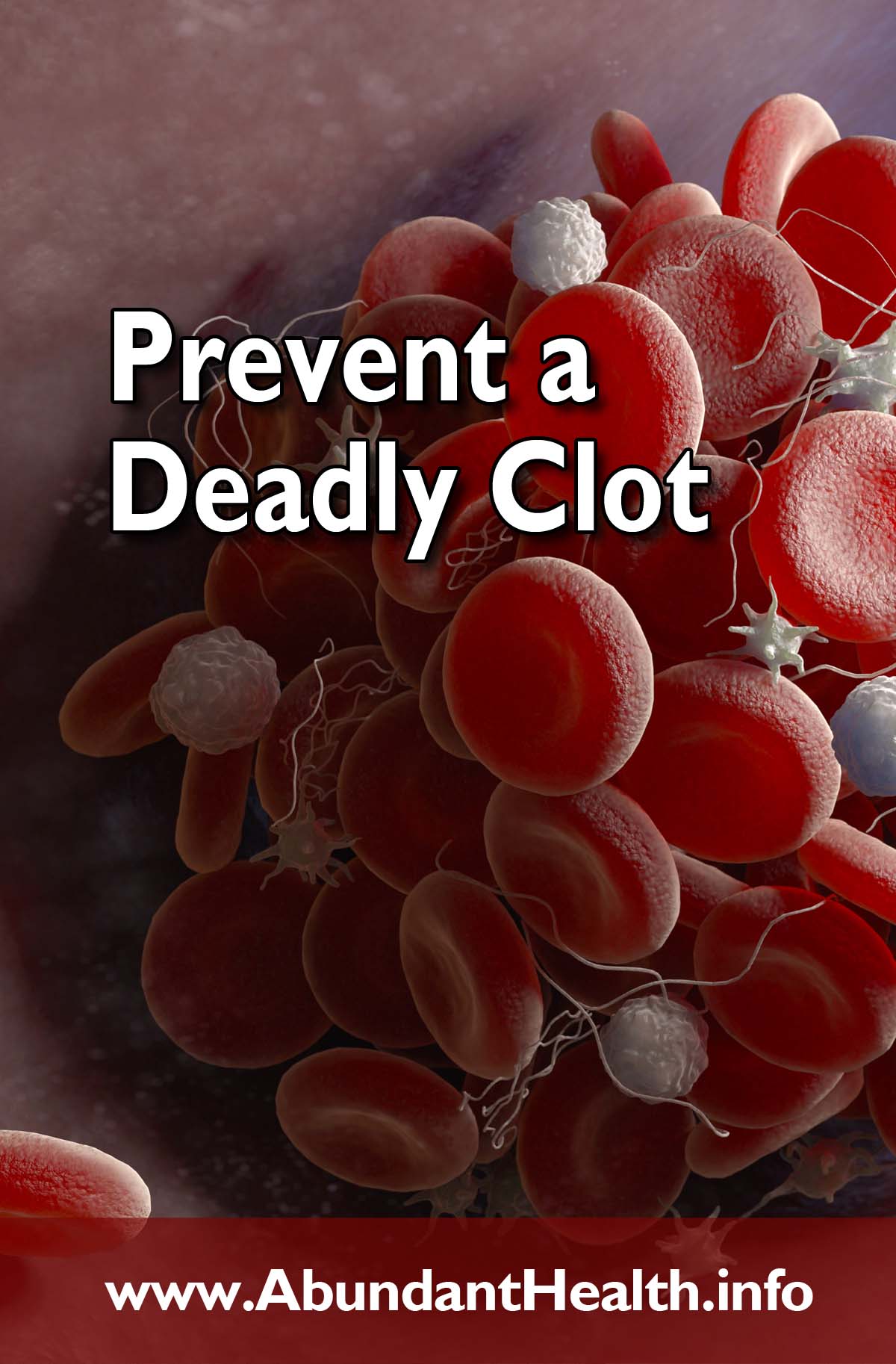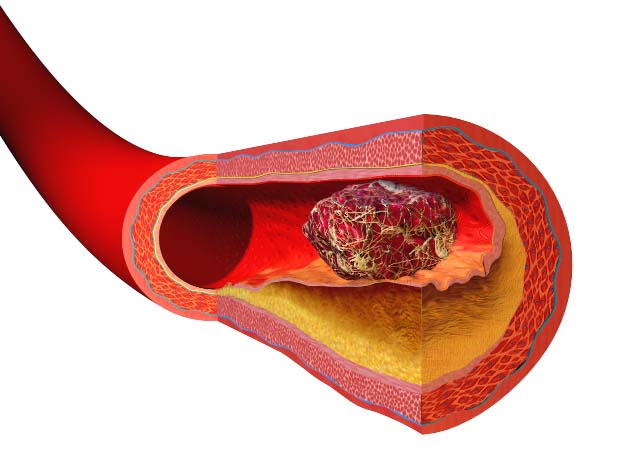Someone in the United States dies from a blood clot every five minutes! One in four people worldwide dies from conditions caused by thrombosis (blood clot). Clots are common in persons who have severe COVID-19. Most clots are preventable.

Unfortunately, sudden death is the first symptom in about 25% of the individuals who have a pulmonary embolism. One-third (about 33%) of people with DVT/PE (deep vein thrombosis/pulmonary embolism)will have a recurrence within 10 years.1)Data and Statistics on Venous Thromboembolism. www.cdc.gov/ncbddd/dvt/data.html
Deep Vein Thrombosis
In fact, each year more people die from deep vein thrombosis than the total number who die from AIDS, breast cancer, and motor vehicle accidents combined. What is DVT? It is the formation of a blood clot in a deep vein, usually in the lower leg or in the thigh. A clot is composed of a meshwork of fibrin threads that entrap plasma, red blood cells, and platelets.
Dangers from DVT
A thrombus is a blood clot that forms within a vessel and remains stationary. It obstructs and slows down blood flow. A clot can dislodge from a deep vein in a leg and travel to the lungs! If not treated promptly, it causes death! Of course, we want our blood to clot when we cut a blood vessel. What we do not want is undesirable clotting which occurs when a clot forms at a site where there is no bleeding, resulting in obstructed blood flow. A clot just the size of a sharpened pencil tip can significantly reduce blood flow. Even worse, clots can dislodge and travel to the lungs or rarely, to the circulation of the heart.
Signs and Symptoms of DVT
Pain, tenderness, swelling, and discoloration in a leg can be signs and symptoms of DVT. More than 70% of individuals who develop DVT will not experience any symptoms until it is too late and the clot has dislodged! Sometimes these symptoms remain and do not disappear with treatment.
Who is at Risk for Clots?
DVT has come to the public’s attention over the past few years after airline passengers on cramped, long-haul flights developed clots in what some have called “economy-class syndrome.” In fact, French studies show that riding in a car or truck for four to five hours without stopping for an exercise break increases the risk of DVT four times.
An extensive database revealed that DVT was twice as high after an acute lung infection. Pulmonary embolisms also doubled after an acute urinary tract infection.2)Smeeth, L. The Lancet, 367:1075-079, April 1, 2006. Men are 50% more likely than women to develop another blood clot after having the first episode of DVT. The overall frequency of recurrent blood clots in men is 25% within a period of five years.3)http://news.bio-medicine.org/medicine-news-3/Men-more-at-risk-of-recurrent-blood-clots-than-women-3748-1/ Another authority states that 1/3 of individuals with DVT will have a re-occurrence within ten years.
More Risk Factors!
Within the human body there is a balance of anti-clotting and pro-clotting factors. Major surgery, trauma, systemic infection, atherosclerosis, atrial fibrillation, heart attack, certain cancers, inflammatory bowel conditions, HIV, prolonged bed rest, physical inactivity and immobility, fractures of the pelvis, hip, or leg, varicose veins, pregnancy, and estrogen-containing pills or patches increase the risk of developing DVT. Unfortunately, the typical Western diet and lifestyle, obesity,4)Web, M.D., Obesity ups the risk of Pulmonary Embolism, DVT, Sept 9, 2005.
Rissanen, P., et al, Weight change and blood coagulability and fibrinolysis in healthy obese women. Int J Obes Relat Metab Disord, 25(2):212-218, 2001. and diabetes5)https://www.lifeclinic.com/focus/Diabetes/Stroke also encourage undesirable clotting by increasing pro-clotting chemicals, making the platelets abnormally sticky and promoting other pro-clotting conditions within the body. Also, these conditions decrease the natural inhibitors of undesirable clot formation.
Clots inside Arteries
Clots often form when the fibrous cap of an atherosclerotic plaque cracks in the arteries. This condition reduces blood flow through that specific artery even more. Undesirable clotting in one of the coronary arteries blocks the blood flow in an arterial branch that supplies the heart muscle and contributes to more than 80% of heart attacks. Clots are also involved in the majority of strokes.

COVID-19 and Clots!
As previously mentioned, both infection and inflammation increase the risk of unwanted blood clots. Individuals who have severe COVID-19 infection are at higher risk of developing blood clots in the veins and arteries. Studies from France and the Netherlands found that 30-70% of severe COVID-19 experienced blood clots in the deep leg veins or the lungs.6)Klok F et.al. Incidence of thrombotic complications in critically ill ICU patients with COVID-19. https://doi.org/10.1016/j.thromres.2020.04.013
Llitjos J et.al. High Incidence of venous thromboembolic events in anticoagulated severe COVID-19 patient. DOI: 10.1111/jth.14869 One-fourth of all COVID-19 patients that are admitted to ICU wards will develop a life-threatening pulmonary embolism. In severe COVID-19 infection, abnormal, small clotting also occurs within the small vessels of the lungs, the kidneys, and the gut. A low dosage of blood thinners is prescribed for individuals who have serious COVID-19 infections. For those who have several risk factors for clots, any infection, including influenza, puts them at greater risk for clots. Many of the same lifestyle practices and natural remedies that reduce one’s risk for blood clotting also help optimize the immune system and reduce inflammation!
How Can We Reduce the Risk of Undesirable Clotting?
Win While You Lose!
To prevent a blood clot, reach and maintain your ideal weight. Obesity increases certain pro-clotting factors in the blood. Researchers at St. Joseph Mercy Oakland Hospital in Pontiac, Michigan, and Wayne State University found that obese patients were 2.5 times more likely to have DVT and 2.2 times more likely to have a pulmonary embolism.7)Ibid, Web, M.D. Fortunately, appropriate weight loss reduces elevated pro-clotting and pro-inflammatory agents in obese individuals.
Don’t Smoke.
Tobacco smoking damages the lining of the blood vessels and increases the clumping of platelets, which in turn, increases the risk for undesirable clot formation.8)Davis, J.W., et al, Effects of tobacco and non-tobacco cigarette smoking on endothelium and platelets. Clin Pharmacol Ther, 37(5):529-533, 1985.
Zhang G. Smoking and risk of venous thromboembolism: a systematic review. Southeast Asian J Trop Med Public Health. 2014 May; 45(3):736-45. www.ncbi.nlm.nih.gov/pubmed/24974658
We should mention here that any factor like smoking which increases the risk for atherosclerosis also increases the likelihood of undesirable clot formation. Even a brief encounter with second-hand smoke can make the platelets sticky and more likely to clot especially in susceptible people.9)Second hand smoke. www.nhsinform.scot/healthy-living/stopping-smoking/reasons-to-stop/second-hand-smoke
Adopt a Healthful, Plant-Based Diet!
Meat and saturated fats increase the risk of clotting by decreasing prostacyclin (a prostaglandin that inhibits platelet clumping and increases clot-encouraging compounds).10)Zhang C. The effects of saturated fatty acids on endothelial cells. www.thrombosisresearch.com/article/0049-3848(92)90226-Z/fulltext As platelets become stickier, the risk of developing undesirable clotting significantly increases. Regular meat consumption fuels inflammation.11)Hruby Dietary Protein and Changes in Biomarkers of Inflammation and Oxidative Stress in the Framingham Heart Study Offspring Cohort. Current Developments in Nutrition, Volume 3, Issue 5, May 2019. academic.oup.com/cdn/article/3/5/nzz019/5421623
Ley SH. Associations between red meat intake and biomarkers of inflammation and glucose metabolism in women. Am J Clin Nutr. 2014 Feb;99(2):352-60. https://www.ncbi.nlm.nih.gov/pubmed/24284436
Seah JY. Consumption of Red Meat, but Not Cooking Oils High in Polyunsaturated Fat, Is Associated with Higher Arachidonic Acid Status in Singapore Chinese Adults. Nutrients. 2017 Jan 31;9(2). pii: E101. www.ncbi.nlm.nih.gov/pubmed/28146136
Chaturvedi P. High Methionine Diet Poses Cardiac Threat: A Molecular Insight. J Cell Physiol. 2016 Jul; 231(7):1554-61. www.ncbi.nlm.nih.gov/pubmed/26565991 Inflammation plays an integral role in most clot formation.12)Brian R. Branchford. The Role of Inflammation in Venous Thromboembolism. Front Pediatr. 2018; 6: 142. www.ncbi.nlm.nih.gov/pmc/articles/PMC5974100/
Foods that Reduce Your Risk!
In contrast, frequent consumption of foods that contain phytochemicals that inhibit platelet clumping like garlic, ginger, onions, tomatoes, red grapes, berries13)McEwen B. The Influence of Diet and Nutrients on Platelet Function. Seminars in Thrombosis and Hemostasis. 40 (2). February 2014. www.researchgate.net/publication/260108030_The_Influence_ofDiet_and_Nutrients_on_Platelet_Function citrus,14)Attaway, J.A., et al, Antithrombogenic and antiatherogenic effects of citrus flavonoids. Contributions of Ralph C. Robbins. Adv Exp Med Biol. 439:165-73, 1998. kiwi,15)Duttaroy, A.K. Effects of kiwi fruit consumption on platelet aggregation and plasma lipids in healthy human volunteers. Platelets, 15(5):287-92, 2004. pomegranates,16)Aviram, M., et al, Pomegranate juice consumption reduces oxidative stress, atherogenic modifications to LDL, and platelet aggregation: studies in humans and in atherosclerotic apolipoprotein E-deficient mice. Am J Clin Nutr, 71(5):1062-1076, 2000. olives17)Massaro, M., et al, Vasculoprotective potential of olive oil components. Mol Nutr Food Res, 51(10):1225-34, 2007. and flaxseed18)Ristić-Medić. Alpha-linolenic acid and cardiovascular diseases. Med Pregl, 56(Suppl 1):19-25, 2003. help to reduce the risk of undesirable clotting.

Be Sure Your B-12 Is in Normal Range!
While it is true that several studies show that a vegetarian diet lowers the risk for cardiovascular disease and may even reverse coronary artery disease, a vegetarian diet without adequate amounts of vitamin B-12 increases the risk for developing an undesirable clot.19)Remacha AF. Vitamin B12 deficiency, hyperhomocysteinemia and thrombosis: a case and control study. Int J Hematol. 2011 Apr; 93(4):458-464. www.ncbi.nlm.nih.gov/pubmed/21475950 Vegans, vegetarians, and the elderly are at risk for vitamin B-12 deficiency.
Check Your Homocysteine Level!
Homocysteine is an amino acid produced by the body. It is usually a byproduct of meat consumption. Elevated homocysteine injures the cells that line the arteries and stimulates the unhealthy growth of arterial smooth muscle cells. Both processes contribute to atherosclerosis. It also increases the risk for undesirable clotting. When elevated, homocysteine enhances the risk of unwanted clotting and blood vessel constriction. Low intake of both vitamin B12 and folic acid increases the risk for elevated homocysteine levels. Vegetarians should have their B12 levels checked every six months if they do not take a vitamin B12 supplement. Kidney disease and low thyroid levels increases one’s risk for elevated homocysteine. There is very early evidence that suggests that having a good vitamin D level may help to keep homocysteine in the normal range.
Engage in Moderate Exercise!
Regular moderate exercise is one of the most important methods for preventing a blood clot. Indeed! Engaging in moderate daily exercise is great preventive and restorative medicine! Sluggish circulation is a major risk factor in developing clots. Moderate exercise increases fibrinolysin which dissolves tiny clots, improves blood flow, and decreases fibrinogen, a plasma protein involved in clot formation. Perform foot exercises while riding in a plane or car. Take exercise breaks during long trips.
Caveats: Extremely competitive and long endurance exercises actually increase the risk of clot formation because they increase the hormone epinephrine. Epinephrine makes platelets sticky and consequently increases the risk of clotting.
Although you might have your daily period for longer exercise, it is essential to get up and walk for at least five minutes every two hours if you are primarily sedentary. Why? Prolonged sitting substantially reduces the blood flow to the legs and increases your risk for the undesirable clot formation.20)https://wildwoodhealth.com/blog/how-5-or-10-minutes-can-improve-your-health/

Stay Hydrated!
Drink water. Adequate hydration and deep breathing also improve blood flow. These two preventive measures are especially important for those with limited mobility. Dehydration thickens the blood. Skip the energy drinks high in caffeine as they can increase the risk for clots.21)McEwen B. The Influence of Diet and Nutrients on Platelet Function. Seminars in Thrombosis and Hemostasis. 40 (2). February 2014. https://www.researchgate.net/publication/260108030_The_Influence_ofDiet_and_Nutrients_on_Platelet_Function
Enjoy Healthful Herbs!
Turmeric, ginger, and ginkgo biloba inhibit platelet clumping as well. Thyme and rosemary have significant antithrombotic factors.22)Yamamoto, J., Testing various herbs for antithrombotic effect. Nutrition, 21(5):5, 2005. www.ncbi.nlm.nih.gov/pubmed/15850964
Zbinden, S. Phytotherapy in cardiovascular medicine. Ther Umsch, 59(6):301-306, 2002.
McEwen B. The Influence of Diet and Nutrients on Platelet Function. Seminars in Thrombosis and Hemostasis. 40 (2). February 2014. www.researchgate.net/publication/260108030_The_Influence_ofDiet_and_Nutrients_on_Platelet_Function However, people who use blood thinners, have low platelet counts, or have bleeding problems should consult their physician before using medicinal amounts of these herbs. Pregnant women should not consume any herb medicinally without prior approval from a knowledgeable, qualified healthcare professional. Blood-thinning herbs, if used medicinally, should usually be discontinued two weeks before any surgery or dental work.
Maintain a Cheerful Outlook.
Acute stress and mental depression can increase the risk of forming an undesirable clot. Major depression, for example, increases platelet aggregation and the risk for cardiovascular events.23)Ziegelstein, R.C., et al, Platelet function in patients with major depression. Intern Med J, 39(1):38-43, 2009. www.ncbi.nlm.nih.gov/pubmed/19220540

Keep Your Blood Sugar within Normal Range.
Nearly 80% of individuals who have diabetes will eventually die of clot-related causes. Emphasize low-glycemic foods that may reduce the risk for undesirable clot formation.
Know Your Heart Health.
Certain irregular heart rhythms (i.e.. atrial fibrillation, first-degree heart block, etc.) or heart attack increases one’s risk for undesirable clotting. Heart failure occurs when the heart does not pump enough blood to keep up with the demands of the body. Consequently, the blood flows more slowly. When this happens, the risk for clot formation increases. Atherosclerosis elevates the risk for blood clotting. Hypertension also increases the risk for deep vein thrombosis.
Emergency!
Clots can be deadly. If you suspect a DVT, see your doctor immediately. Shortness of breath accompanied by sharp chest pain, cough, or anxiety indicate a life or death situation. Possible other signs of pulmonary embolism include light-headedness, blood-stained sputum, or a bluish tint in the skin. Medical treatment consists of anticoagulant medication and thrombolytic therapy designed to break up or dissolve the clot. Time is of the essence here. A clot in the lungs can kill a person within minutes.
Clots in the coronary arteries or inside the brain can prove deadly. So follow your doctor’s instructions!
Conclusions
Some medical epidemiologists state that between one and two million Americans develop DVT annually. One expert predicts that one to three individuals out of a thousand in the United Kingdom will get DVT. What are your chances of developing DVT? It greatly depends on your lifestyle. The good news is that most clots are preventable. If they are caught early, often they are treatable. Better yet, see your health care provider if you are at risk for DVT!

Stay Always Up to Date
Sign up to our newsletter and stay always informed with news and tips around your health.
This article was originally posted on the Wildwood Institute website and is used by permission.
Elizabeth Hall has taught and researched health topics for more than 35 years at Wildwood Lifestyle Center and Hospital at Wildwood, GA.
References
| ↑1 | Data and Statistics on Venous Thromboembolism. www.cdc.gov/ncbddd/dvt/data.html |
|---|---|
| ↑2 | Smeeth, L. The Lancet, 367:1075-079, April 1, 2006. |
| ↑3 | http://news.bio-medicine.org/medicine-news-3/Men-more-at-risk-of-recurrent-blood-clots-than-women-3748-1/ |
| ↑4 | Web, M.D., Obesity ups the risk of Pulmonary Embolism, DVT, Sept 9, 2005. Rissanen, P., et al, Weight change and blood coagulability and fibrinolysis in healthy obese women. Int J Obes Relat Metab Disord, 25(2):212-218, 2001. |
| ↑5 | https://www.lifeclinic.com/focus/Diabetes/Stroke |
| ↑6 | Klok F et.al. Incidence of thrombotic complications in critically ill ICU patients with COVID-19. https://doi.org/10.1016/j.thromres.2020.04.013 Llitjos J et.al. High Incidence of venous thromboembolic events in anticoagulated severe COVID-19 patient. DOI: 10.1111/jth.14869 |
| ↑7 | Ibid, Web, M.D. |
| ↑8 | Davis, J.W., et al, Effects of tobacco and non-tobacco cigarette smoking on endothelium and platelets. Clin Pharmacol Ther, 37(5):529-533, 1985. Zhang G. Smoking and risk of venous thromboembolism: a systematic review. Southeast Asian J Trop Med Public Health. 2014 May; 45(3):736-45. www.ncbi.nlm.nih.gov/pubmed/24974658 |
| ↑9 | Second hand smoke. www.nhsinform.scot/healthy-living/stopping-smoking/reasons-to-stop/second-hand-smoke |
| ↑10 | Zhang C. The effects of saturated fatty acids on endothelial cells. www.thrombosisresearch.com/article/0049-3848(92)90226-Z/fulltext |
| ↑11 | Hruby Dietary Protein and Changes in Biomarkers of Inflammation and Oxidative Stress in the Framingham Heart Study Offspring Cohort. Current Developments in Nutrition, Volume 3, Issue 5, May 2019. academic.oup.com/cdn/article/3/5/nzz019/5421623 Ley SH. Associations between red meat intake and biomarkers of inflammation and glucose metabolism in women. Am J Clin Nutr. 2014 Feb;99(2):352-60. https://www.ncbi.nlm.nih.gov/pubmed/24284436 Seah JY. Consumption of Red Meat, but Not Cooking Oils High in Polyunsaturated Fat, Is Associated with Higher Arachidonic Acid Status in Singapore Chinese Adults. Nutrients. 2017 Jan 31;9(2). pii: E101. www.ncbi.nlm.nih.gov/pubmed/28146136 Chaturvedi P. High Methionine Diet Poses Cardiac Threat: A Molecular Insight. J Cell Physiol. 2016 Jul; 231(7):1554-61. www.ncbi.nlm.nih.gov/pubmed/26565991 |
| ↑12 | Brian R. Branchford. The Role of Inflammation in Venous Thromboembolism. Front Pediatr. 2018; 6: 142. www.ncbi.nlm.nih.gov/pmc/articles/PMC5974100/ |
| ↑13 | McEwen B. The Influence of Diet and Nutrients on Platelet Function. Seminars in Thrombosis and Hemostasis. 40 (2). February 2014. www.researchgate.net/publication/260108030_The_Influence_ofDiet_and_Nutrients_on_Platelet_Function |
| ↑14 | Attaway, J.A., et al, Antithrombogenic and antiatherogenic effects of citrus flavonoids. Contributions of Ralph C. Robbins. Adv Exp Med Biol. 439:165-73, 1998. |
| ↑15 | Duttaroy, A.K. Effects of kiwi fruit consumption on platelet aggregation and plasma lipids in healthy human volunteers. Platelets, 15(5):287-92, 2004. |
| ↑16 | Aviram, M., et al, Pomegranate juice consumption reduces oxidative stress, atherogenic modifications to LDL, and platelet aggregation: studies in humans and in atherosclerotic apolipoprotein E-deficient mice. Am J Clin Nutr, 71(5):1062-1076, 2000. |
| ↑17 | Massaro, M., et al, Vasculoprotective potential of olive oil components. Mol Nutr Food Res, 51(10):1225-34, 2007. |
| ↑18 | Ristić-Medić. Alpha-linolenic acid and cardiovascular diseases. Med Pregl, 56(Suppl 1):19-25, 2003. |
| ↑19 | Remacha AF. Vitamin B12 deficiency, hyperhomocysteinemia and thrombosis: a case and control study. Int J Hematol. 2011 Apr; 93(4):458-464. www.ncbi.nlm.nih.gov/pubmed/21475950 |
| ↑20 | https://wildwoodhealth.com/blog/how-5-or-10-minutes-can-improve-your-health/ |
| ↑21 | McEwen B. The Influence of Diet and Nutrients on Platelet Function. Seminars in Thrombosis and Hemostasis. 40 (2). February 2014. https://www.researchgate.net/publication/260108030_The_Influence_ofDiet_and_Nutrients_on_Platelet_Function |
| ↑22 | Yamamoto, J., Testing various herbs for antithrombotic effect. Nutrition, 21(5):5, 2005. www.ncbi.nlm.nih.gov/pubmed/15850964 Zbinden, S. Phytotherapy in cardiovascular medicine. Ther Umsch, 59(6):301-306, 2002. McEwen B. The Influence of Diet and Nutrients on Platelet Function. Seminars in Thrombosis and Hemostasis. 40 (2). February 2014. www.researchgate.net/publication/260108030_The_Influence_ofDiet_and_Nutrients_on_Platelet_Function |
| ↑23 | Ziegelstein, R.C., et al, Platelet function in patients with major depression. Intern Med J, 39(1):38-43, 2009. www.ncbi.nlm.nih.gov/pubmed/19220540 |
Leave a Reply